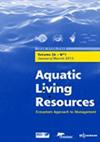Bonamia-free flat oyster (Ostrea edulis L.) seed for restoration projects: non-destructive screening of broodstock, hatchery production and test for Bonamia-tolerance
IF 1.9
4区 农林科学
Q3 FISHERIES
引用次数: 0
Abstract
Native (flat) oyster (Ostrea edulis) beds, once a major component of the North Sea, largely disappeared from the region in the late 19th century. Flat oyster restoration is taking place at a number of locations in the North Sea. When flat oyster beds are restored in areas where O. edulis is functionally extinct it is advised to treat these as disease-free areas. Adult oysters were collected in the Dutch Delta area which is infected with the pathogenic parasite Bonamia ostreae. The aim of this research was to obtain Bonamia-free seed from parents collected in a Bonamia-infected area. In addition, the oysters were analysed to identify candidate genomic regions related to bonamiosis tolerance and exposed to Bonamia in the field to assess survival compared to a naïve control group. With the aid of a non-destructive screening method, Bonamia-free broodstock were selected. These oysters produced Bonamia-free larvae and seed. For comparison, broodstock oysters were collected in the Dutch Wadden Sea, an area free of Bonamia. These oysters also produced Bonamia-free larvae and seed. To study if the Delta area oysters had developed a degree of resistance to the disease, while the naïve Wadden Sea oysters had not, seed of both groups was challenged in Lake Grevelingen where Bonamia occurs. Survival of the pre-selected Bonamia-free oysters was significantly higher than the naïve group. Samples of seed were analysed for association of candidate genetic markers related to bonamiosis tolerance. A higher percentage of individuals with tolerance-associated marker genotypes was found in the screened group compared to the naïve one. However, mortality of the naïve group could not be related to Bonamia presence. Further challenge tests are needed before firm conclusions regarding the genetic markers can be made. The results show that hatchery production of Bonamia-free and potentially Bonamia-tolerant flat oysters is possible.
无波那米亚平牡蛎(Ostrea edulis L.)种子恢复工程:亲鱼无损筛选、孵化场生产和波那米亚耐药试验
原生(扁平)牡蛎(Ostrea edulis)床,曾经是北海的主要组成部分,在19世纪后期大部分从该地区消失。北海的一些地方正在进行扁平牡蛎的恢复。当在edulis功能性灭绝的地区恢复平坦的牡蛎床时,建议将这些地区视为无病地区。在荷兰三角洲地区采集的成年牡蛎感染了致病性寄生虫ostreae。本研究的目的是从疫区收集的亲本中获得无博纳米亚病的种子。此外,对牡蛎进行了分析,以确定与博纳米亚病耐受性相关的候选基因组区域,并在野外暴露于博纳米亚病,以评估与naïve对照组相比的存活率。采用非破坏性筛选法筛选无博纳米亚亲鱼。这些牡蛎产生无博纳米亚的幼虫和种子。为了进行比较,在荷兰瓦登海收集了亲牡蛎,这是一个没有博纳米亚的地区。这些牡蛎也产生无博纳米亚的幼虫和种子。为了研究三角洲地区的牡蛎是否对这种疾病产生了一定程度的抵抗力,而naïve瓦登海的牡蛎则没有,研究人员在博纳米亚病发生的格列维林根湖对两组牡蛎的种子进行了挑战。预先选择的无博纳米亚牡蛎的存活率显著高于naïve组。对种子样本进行了分析,以确定与bonamosis耐受性相关的候选遗传标记的相关性。与naïve组相比,筛选组具有耐受性相关标记基因型的个体百分比更高。然而,naïve组的死亡率与Bonamia的存在无关。在对遗传标记作出确切结论之前,需要进行进一步的挑战测试。结果表明,养殖无博纳米菌和潜在耐博纳米菌的扁平牡蛎是可能的。
本文章由计算机程序翻译,如有差异,请以英文原文为准。
求助全文
约1分钟内获得全文
求助全文
来源期刊

Aquatic Living Resources
农林科学-海洋与淡水生物学
CiteScore
2.30
自引率
0.00%
发文量
10
审稿时长
>24 weeks
期刊介绍:
Aquatic Living Resources publishes original research papers, review articles and propective notes dealing with all exploited (i.e. fished or farmed) living resources in marine, brackish and freshwater environments.
Priority is given to ecosystem-based approaches to the study of fishery and aquaculture social-ecological systems, including biological, ecological, economic and social dimensions.
Research on the development of interdisciplinary methods and tools which can usefully support the design, implementation and evaluation of alternative management strategies for fisheries and/or aquaculture systems at different scales is particularly welcome by the journal. This includes the exploration of scenarios and strategies for the conservation of aquatic biodiversity and research relating to the development of integrated assessment approaches aimed at ensuring sustainable and high quality uses of aquatic living resources.
 求助内容:
求助内容: 应助结果提醒方式:
应助结果提醒方式:


